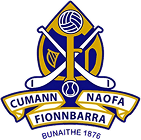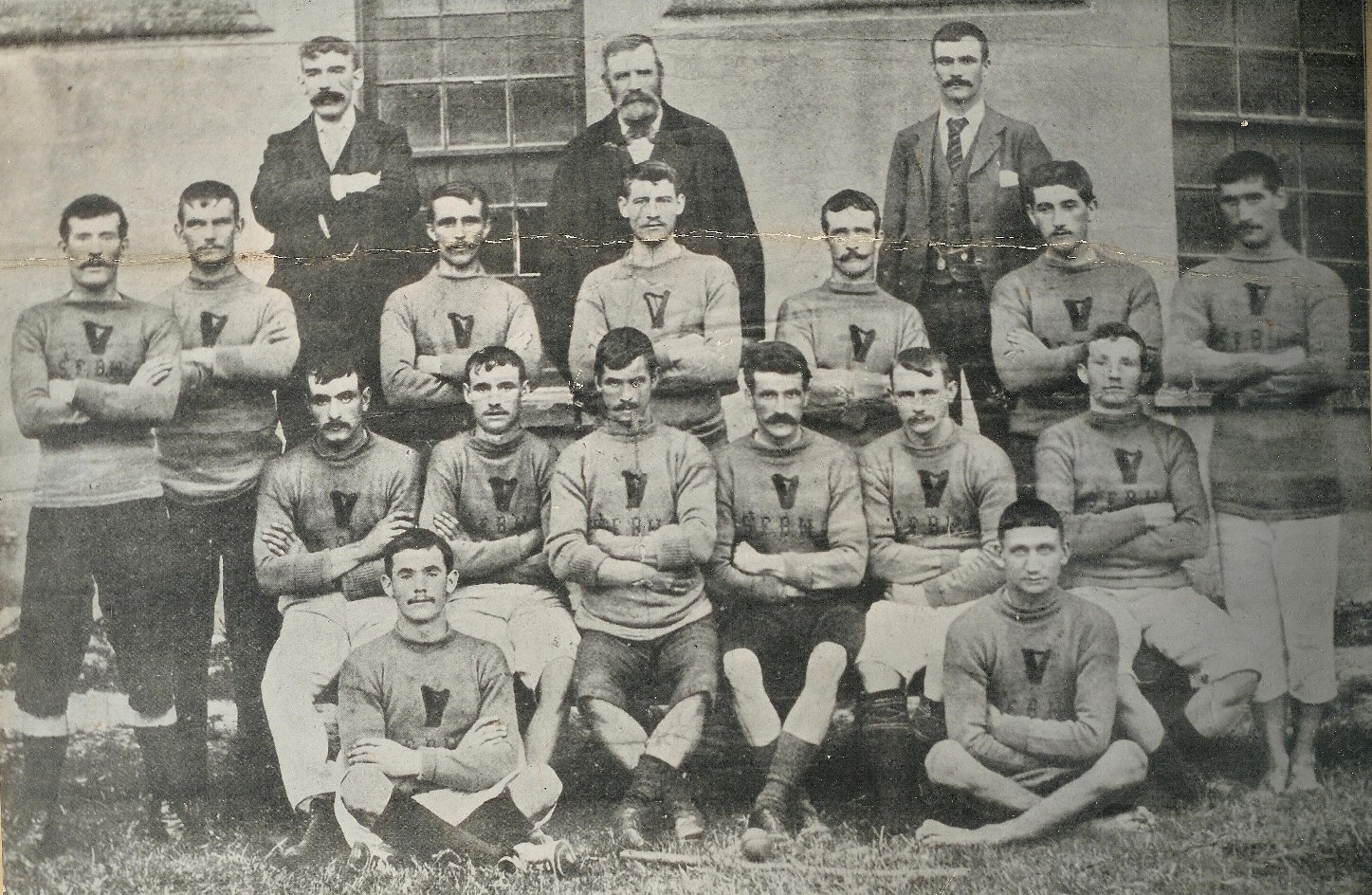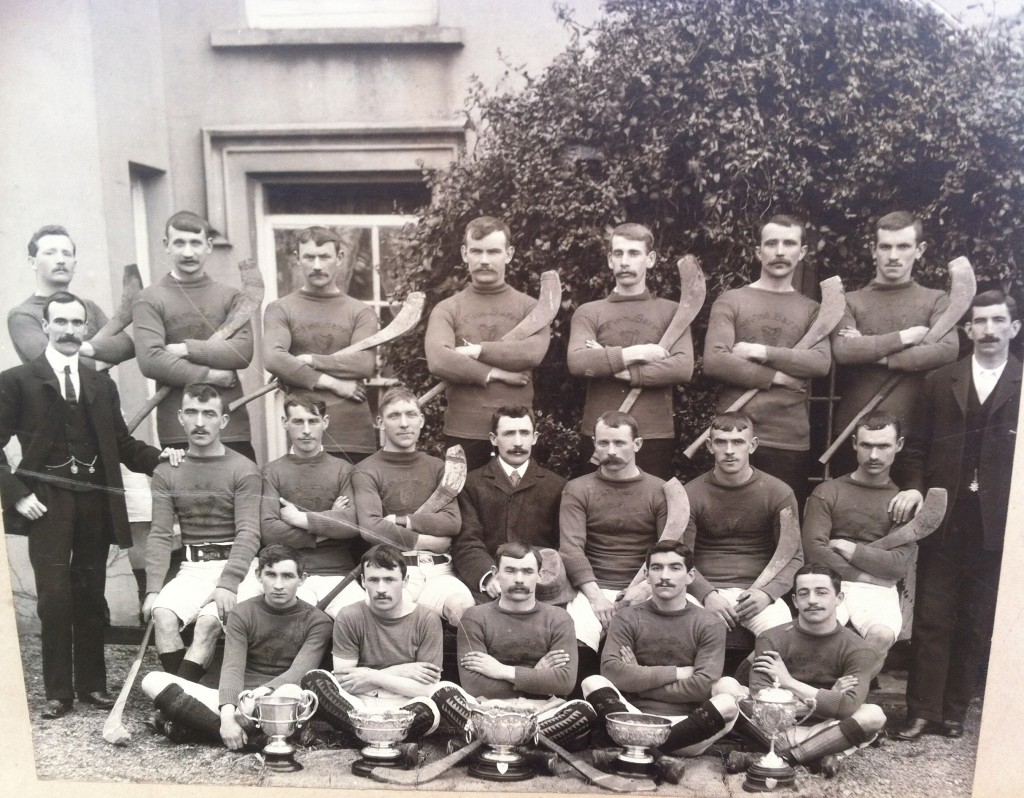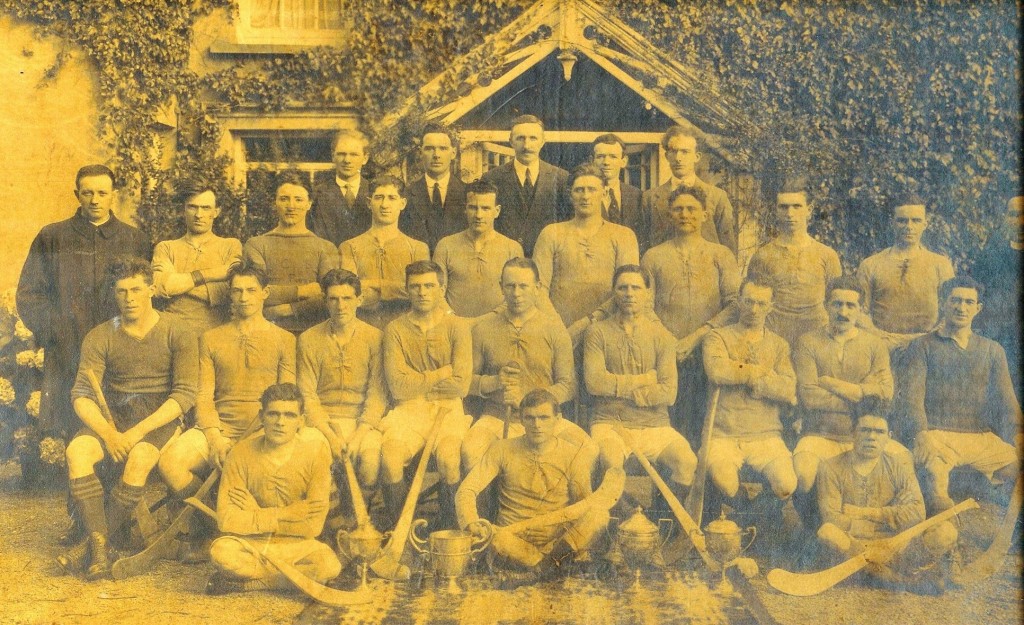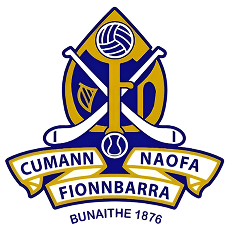St Finbarr’s GAA Club was active and competitive in the years long before the founding of the Association in 1884. Sean McCarthy, Cork’s great ex President of the Association, writing of the year 1876, recounted how the Barr’s had beaten Cloughroe, Ballygarvan, Aglish, Carrigaline, Shanbally and Blackrock all in that same year. There can be no doubt that the Barr’s entered the GAA with the most enviable tradition behind them. How they have upheld this tradition will be captured throughout these pages. Year after year, great hurlers wore their famous blue from Willie John O’Connell of the formative days to Sean Condon and Gerald McCarthy in more modern times.
Though the ‘Barr’s name doesn’t appear in the record books until 1899 they had already won an unofficial County in 1890 under Fr O’Connor’s Board. There was political turmoil within the county Board in 1889 and Fr. O’Connor, President of the Board, resigned. Why? He claimed it was a “packed” meeting with a lot of non nationalists believed to be associated with individuals who had connections within Dublin Castle being elected. The Barr’s endorsed the view of its president and were supported by Blackrock, Ballygarvan and Ballyhooley who withdrew from the County Championship. Those clubs were suspended along with five others. Aghabullogue was the only higher ranked club to remain loyal to the County Board after Greenmount proposed a motion condemning the expulsions. The disaffected clubs regrouped and formed the O’Connor Board and received support from another rival group North Cork who set up the O’Brien Board. Fr O’Connor, in 1889, presented a Cup for competition which was won by the ‘Barr’s who defeated the Rockies in the final after earlier seeing of the challenges of St Peter’s and St Paul’s, Greenmount and Little Island. The victorious Barr’s team included the following; John Canniffe, John Cronin, Dan Murphy, Philip Murphy, Wm Callaghan, Michael McCarthy, Dan Knowles, John Nunan, Jeremiah Sheehan, John Sheehan, Dan Sheehan, John Walsh, Denis Carey, James Conway, Thomas Horgan, Willie John O’Connell, Ml O’Keeffe, John Leahy, Tim Desmond, Dan Callaghan, Patrick Murphy.
Twenty two teams competed in the Cork and O’Brien Boards County Championship in 1890 for the O’Connor Cup with the Barr’s and Bartlemy winning the respective sections. A huge gathering converged on Mallow town for the decider after which the Barr’s retained the trophy and returned to the city in triumph. Barr’s (21 a side); William O’Callaghan (capt), John Leahy, Ml O’Keeffe, Dan O’Callaghan, Tim Horgan, John Walsh, James Barrett, Dan Murphy, James Keegan, Denis Carey, Michael Casserly, Willie John O’Connell, John Canniffe, Philip Murphy, James Dennehy, Denis Bradley, Ml McCarthy, Jerh. Sheehan, Denis Halloran, Michael Sheehan, John Noonan.
The Barr’s returned to the official county board in 1891. Unfortunately, the glory of the 1890 victories was quickly followed by the reproach of the “Parnell Split”. The Kitty O’Shea affair had thrown the country into turmoil, split the Irish Republican Party into two factions, Wm O’Briens and Redmondites. This split pervaded most organisations including the Barr’s. At one infamous club meeting in 1891, no fewer than twelve (the Apostles) of the Blues first team, Wm O’Callaghan, Ml Cassidy, J Leahy, Joseph Keegan, Denis O’Mahony, Dan Knowles, Con Ahern, Denis Hegarty, Ml Sheehan, Ml Hegarty, John Healy and John Noonan left the room to join Redmond’s. Most of the remainder affiliated with O’Briens resulting in the Barr’s absence for the 1892 season. Following their departure the Barr’s turned to untried youngsters who, with the help of Willie John, Jim Young and a few Sheehans, developed into outstanding hurlers. Within a few years Barr’s were a force again and when County champions Blackrock were selecting their team to represent Cork in the All-Ireland they called on Willie John and Jim Young. The Barr’s men played outstanding roles. The two years since the split were very troublesome for the Barr’s who were on their knees but it is to their eternal credit that they came roaring back to again become the county’s premier club and one of those inspiring the comeback was Billex Moloney; strong and fast he became one of the best defenders of all time. In his book “Twenty years of the GAA”, Corkonian Phil O’Neill wrote, ‘Billex was one of the oldest leading players of the Barr’s club. He was one of the greatest and most popular players of the game and became a regular on the Cork senior team. His participation dated back to the 21 a side games. Another distinction “though not the most enviable” is that he was probably the greatest player of his time who never won an All-Ireland medal, and this covered a period of over twenty years. Once, he came within a point of premier honours; that was in 1906 when Kilkenny (Tularoon) defeated Cork (St Finbarr’s) at Carrick on Suir by 1-9 to 1-8. The following year he had even worse luck as his team, which included “Bachus” Leary, “Chateye” Leary, “Dowdy” Kelly, Christy Young, Jerry Beckett, Christy Nolan, D Linehan of the Blues, beat the champs in Tipperary in the final but the “Cats” objected as the Cork keeper Sonny Jim McCarthy was a British Army Reservist. A re-fixture was ordered and Kilkenny retained their crown. When Billex laid down his camán for the last time, after a match in which three of his ribs were broken, Cork lost their noblest hurler. Yet, even when he could no longer line out he trained and selected the teams.”
It was ironic that when the Barr’s claimed their first official county championship in 1899 that their opponents were arch enemies Redmond’s to which most of their stars had defected eight years earlier. Sadly, that darling hurler inter county star Willie John O’Connell was an absentee. Willie John was revered in the parish and was destined for greatness. A fast, sweet hurler he was a long serving Barr’s captain. He loved hurling and lived for it. Then fate decreed that he should also die for it. In training with the county team in the Park, on the 25th April 1897, he received an accidental blow to the head from which died. Whatever other differences and prejudices existed the 1899 final was worthy of the sport and the men. Both teams fought manfully in a sportsmanlike spirit to secure the laurels of victory which went to “the Gallant old Blues” by the slenderest of margins. Barr’s : J Young, P Conway, W Moloney, M Sexton, C Young, J Young, W Sheehan, D Sheehan, J Harrington, D Harrington, J Cashman, T O’Keeffe, T Foley, P O’Sullivan, J Kelleher, J Delea, C O’Leary.
St Finbarr’s Hurling Club Cork County Champions 1899. Back: Paddy Canniffe, Dan O’Brien, Mick McCarthy. Third row.: Josie Kelleher, Wm ‘Billex’ Moloney, Jack Delea, Pat O’Sullivan, Jim Young, Jack Cantillon, Cocker Foley. Seated: Mick Sexton, Rocket Sheehan, Tim Murphy, Paddy Conway, Faun Harrington, Christy Young. Front: Jim Harrington, Sugar Sheehan. Missing from photo: Con O’Leary, Tim O’Keeffe.
Barr’s recorded their biggest tournament success in 1902 when they won the Cork International Exhibition Tournament staged as part of the attractions of the International Exhibition held in Cork. It was intended that the hurling would be worthy demonstrations of the skill and excitement of our native pastime. The event attracted exhibitors from across the globe, displaying their industrial, agricultural and artistic wares. It opened on 1 May 1902 amid scenes of celebration and enthusiasm. Its success surpassed all expectations, attracting visitors from all over Ireland, Europe and beyond. Over a million people attended the exhibition and it’s not certain if the royal guests, King Edward VII and Queen Alexandra, got to witness the Barr’s triumph.
For three consecutive years (1904-’06 ) they dominated the senior championship winning three counties in a row as confusion reigned in that period; the 1904 final was two years behind schedule; the Barr’s, conquerors of All-Ireland champions Dungourney in the semi-final, gained a bloodless victory when, an eternity later, final opponents Castletownroche failed to put in an appearance. Delays continued and the 1905 competition was never played. In the belated 1906 county renewal Barr’s and Ballymartle qualified for the final and it was agreed that the championships of both 1905 and 06 would be at stake. Ballinhassig was the venue and on a bitterly cold day in early February 1907 Barr’s were victorious. Barr’s ; David Hurley, Christy Young, Billix Moloney, Denis O’Leary, Jackie Cotter, Christy Nolan, Denis Harrington, Michael ‘Bachus’ O’Leary, Eugene Long, PaitchÃn Sullivan, Jim Harrington, B Young, Denis McCarthy, William ‘Rocket’ Sheehan, John ‘Dowdy’ Kelly, T ‘Cocker’ Foley, Denis ‘Sailor’ Sheehan. Subs: John Delea, Murty Downey, P Conway, Charlie Punch, P Flannery, Denis Linehan, J Twomey.
St Finbarr’s Cork County Hurling Champions 1904-’05-’06. Back: C Young, D Sheehan, W Kelly, W Moloney, D Linehan, J Delea, J Twomey. Centre: M McCarthy, M O’Leary, D Hurley, D McCarthy, J Young, D Harrington (capt), D O’Leary, W Sheehan, J Long, Front: P Flannery, B Young, J Harrington, E Long, C Nolan.
This was probably the last match Rocket Sheehan played for the Blues as he emigrated to Detroit. He carried his camán with him and was instrumental in organising a hurling team in his new home district.
Old time scribes agree that some of the Barr’s legends were amongst the games’ greatest exponents. Bachus Leary had few equals, Christy Young was rock solid and a match for any mortal, the Harringtons were exquisite hurlers while Christy Nolan’s stickwork was not matched until the emergence of Tipperary great, D’Arcy. Patcheen Sullivan was another master craftsman and along with Bachus was chosen by Blackrock for their All-Ireland conquering side in 1903. Famed hurling families, the Dooleys and Sheehans, combined to form the district’s first camogie club in 1905; Mary Agnes Sheehan ( sister of ‘Rocket’) and Katie Dooley (daugher of Tom) formed Clan Eimear based in the Gould Street area who were trained down in the Lough by Liam [Ruiséal], the well known bookseller. However, not all were pleased with the prospect of women playing hurling and Fr Fleming of the Lough Parish condemned what he termed the unfeminine activities of the camogie players. Even though their membership was never continuous they remain as one of the oldest surviving clubs in the county. When Cork beat Antrim in the 1911 All-Ireland Football final Barr’s hurlers Jack Young and Paddy O’Connell, representing Nils Gaelic football, starred on the winning team.
1919 was a red letter year in the history of the club. For some years they had been going through a lean period mainly because the Parish had two rival senior teams pulling against each other- Fr O’Leary TA Hall and the Barr’s. Both suffered as a consequence and an amalgamation was agreed, Connie Neenan , Denis Ring, Jack Dorney, Tom Ahern, Pat Canton, John Herlihy and the legendary Dannix Ring all switching to the Barr’s. This union was a blessing and the parish was united behind the Blues. The alliance of the two clubs brought together a first class combination of players. The Lough Parish team set new standards and remained unbeaten for 18 months, bridging a ten year gap when comprehensively defeating the Rockies in the county final. The ‘Magnificent Seven’ from Fr. O’Leary Hall were joined by Dan Coughlan, John Finn, Tim Finn, Jerry Beckett, Stocky Cronin, Jim ‘Spud’ Murphy, Brawny O’Brien and Joe Ronayne.
Barr’s County Champions 1919-’22’23. Back: D Ellis, D Cahill, M Callanan, J O’Donoghue, J Lynch. 3rd Row: Fr Barrett, T O’Brien, F Murphy, D Ring, J Bennett, P Ryan, M O’Connell, J B Murphy, P Canton, Fr Cahilnane. Seated: J Higgins, J Clarke, S Murphy, J Herlihy, M O’Brien, T Finn, D Coughlan, J Dorney, D S Ring. Front: M Cronin, T Cronin, C Cronin.
Ten days later, 21 September, Cork was back in the All-Ireland Hurling final and wore the red jerseys discarded by the defunct Fr OâLeary Hall team. Despite their immense displays throughout the county championship campaign the Barrâs only representative on the team which defeated Dublin was Dannix Ring. Danny Coughlan, an iconoic figure, was a sub. Spud Murphy who had been a regular on the county team for over a decade was denied the opportunity of gaining the coveted Celtic Cross. Spud was one of the countryâs most popular players and his clashes with the great Tyler Mackey of Limerick were always worth the admission alone.
The early twenties when the War of Independence was followed by Civil War were difficult for organised sports. Consequently, the 1920 county championships were not concluded until 1922 when the Barrâs relinquished their title to the Rockies. The teams were due to meet again five months later in the final of the 1922 County Championship; this time Blackrock pleaded for a postponement citing injuries sustained in their semi-final win over Sarâs. Their appeal fell on deaf ears and the title was awarded to the Barrâs. Of course it was a hollow victory and the Barrâs had to live with the jibes and taunts of opponents particularly those from Blackrock. As a result the destination of the 1923 title would answer many questions. It was generally felt that Blackrock, as a result of some brilliant performances, would encounter little difficulty in regaining their crown. Barrâs, keen to prove their worthiness as champions, were hungry for success. The dream final materialised as the counties leading exponents Barrâs and Blackrock locked horns in the decider. At the end of a fiercely fought hourâs hurling Barrâs deservedly retained custody of the Blue Riband of Cork hurling. Barrâs: Maurice OâBrien, Pat Canton, John Dorney, John Barry Murphy, Dannix Ring, Denis Ring, Michael OâConnell, Thomas OâBrien, Tim Finn, John Clarke, John Herlihy, Pat Ryan, John Higgins, Dan Coughlan, Stephen Murphy. Blackrock bounced back and in 1924 and â25 were convincing county champions. Dannix Ring was one of just two Cork players chosen on the Ireland International Hurling team which defeated America in the Tailteann Games
